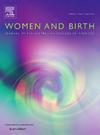Postnatal care and pathways for childbirth-related perineal trauma in England: A qualitative study of healthcare professionals' experiences and perspectives on future development
IF 4.1
2区 医学
Q1 NURSING
引用次数: 0
Abstract
Background
Perineal trauma is a common outcome of vaginal birth, affecting 8/10 women in the UK. While many injuries heal without issue, complications such as infection, wound breakdown, and pain can impact maternal recovery, daily functioning, and wellbeing. Despite the burden of complications, postnatal wound management remain inconsistent, with limited evidence to guide optimal care.
Purpose
To examine the current postnatal care provision and care pathways used by healthcare professionals to address childbirth-related perineal trauma in England and explore their views on enhancing care. Methods: The study was guided by an interpretive descriptive approach. Data was collected using semi-structured interviews with national health service healthcare professionals providing care to women following childbirth-related perineal trauma. Demographic data were analysed using descriptive statistics. Interview data were analysed by hybrid codebook thematic analysis.
Results
Healthcare professionals were interviewed in 2024 (N = 36). The current care provided for childbirth-related perineal trauma is described and represented visually, indicating that multiple care pathways and healthcare services are used. Healthcare professionals reported that improvements to childbirth-related perineal trauma care could come from enhancements to maternal awareness and information; healthcare professional education and training; and standardised evidence-based care pathways both for universal postnatal care and specialist childbirth-related perineal trauma care.
Conclusions
This study offers a unique insight postnatal care for women following childbirth-related perineal trauma in England, revealing a complex and regionally variable landscape. Healthcare professionals highlighted the need for greater standardisation and targeted improvements in care pathways to enhance outcomes for women.
产后护理和途径分娩相关的会阴创伤在英格兰:卫生保健专业人员的经验和未来发展的观点的定性研究
背景会阴创伤是阴道分娩的常见后果,影响了英国8/10的女性。虽然许多伤口可以毫无问题地愈合,但感染、伤口破裂和疼痛等并发症会影响产妇的康复、日常功能和健康。尽管有并发症的负担,产后伤口管理仍然不一致,指导最佳护理的证据有限。目的探讨英国医疗保健专业人员处理分娩相关会阴创伤的产后护理和护理途径的现状,并探讨他们对加强护理的看法。方法:本研究采用解释性描述方法。数据收集采用半结构化访谈与国家卫生服务保健专业人员提供护理的妇女分娩相关的会阴创伤。人口统计数据采用描述性统计进行分析。访谈数据采用混合代码本主题分析方法进行分析。结果2024年受访卫生专业人员(N = 36)。目前提供的护理分娩相关的会阴创伤是描述和视觉表示,表明多种护理途径和医疗服务的使用。医疗保健专业人员报告说,改善与分娩有关的会阴创伤护理可以通过提高产妇的意识和信息来实现;医疗保健专业教育和培训;以及标准化的循证护理途径,用于普遍的产后护理和与分娩相关的会阴创伤专科护理。结论:本研究为英国分娩相关会阴创伤妇女的产后护理提供了独特的见解,揭示了一个复杂的地区差异景观。保健专业人员强调,需要加强标准化和有针对性地改进护理途径,以提高妇女的治疗效果。
本文章由计算机程序翻译,如有差异,请以英文原文为准。
求助全文
约1分钟内获得全文
求助全文
来源期刊

Women and Birth
NURSING-OBSTETRICS & GYNECOLOGY
CiteScore
7.20
自引率
13.20%
发文量
371
审稿时长
27 days
期刊介绍:
Women and Birth is the official journal of the Australian College of Midwives (ACM). It is a midwifery journal that publishes on all matters that affect women and birth, from pre-conceptual counselling, through pregnancy, birth, and the first six weeks postnatal. All papers accepted will draw from and contribute to the relevant contemporary research, policy and/or theoretical literature. We seek research papers, quality assurances papers (with ethical approval) discussion papers, clinical practice papers, case studies and original literature reviews.
Our women-centred focus is inclusive of the family, fetus and newborn, both well and sick, and covers both healthy and complex pregnancies and births. The journal seeks papers that take a woman-centred focus on maternity services, epidemiology, primary health care, reproductive psycho/physiology, midwifery practice, theory, research, education, management and leadership. We also seek relevant papers on maternal mental health and neonatal well-being, natural and complementary therapies, local, national and international policy, management, politics, economics and societal and cultural issues as they affect childbearing women and their families. Topics may include, where appropriate, neonatal care, child and family health, women’s health, related to pregnancy, birth and the postpartum, including lactation. Interprofessional papers relevant to midwifery are welcome. Articles are double blind peer-reviewed, primarily by experts in the field of the submitted work.
 求助内容:
求助内容: 应助结果提醒方式:
应助结果提醒方式:


